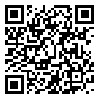BibTeX | RIS | EndNote | Medlars | ProCite | Reference Manager | RefWorks
Send citation to:
URL: http://jhr.ssu.ac.ir/article-1-352-en.html

 , Morad ali Zareipour2
, Morad ali Zareipour2 
 , Mahdi Abdolkarimi1
, Mahdi Abdolkarimi1 
 , Arefeh Dehghani tafti3
, Arefeh Dehghani tafti3 
 , Tahereh Rahimi *4
, Tahereh Rahimi *4 

2- Department of Health Education and Health Promotion, Urmia Health Center, Urmia University of Medical Sciences, Urmia, Iran
3- Department of biostatistics and epidemiology. School of public health, Shahid Sadoughi University of Medical Sciences, Yazd, Iran
4- Department of Health Education and Health Promotion, School of public health, Shahid Sadoughi University of Medical Sciences, Yazd, Iran ,
Introduction: Nowadays, use of virtual socail networks is increasing . However, few studies have been conducted about factors influencing the use of social networks by using theories of health education among students. The present study was to determine predictive factors of virtual social networks among students of Yazd university of medical sciences based on the constructs of the Theory of Planned Behavior.
Methods: This cross-sectional study was conducted on 300 Students in 2016, who were selected by stratified random sampling method. The study data was collected from a questionnaire based on the constructs of the Theory of Planned Behavior including attitudes, subjective norms, perceived behavioral control, and behavioral intentions and behaviors. The data collected were then analyzed via the SPSS Software using descriptive statistics, Pearson product-moment correlation test, one-way analysis of variance, and regression.
Results: The mean age of university students was 22.28±3.69 years. The results also suggested that 98.3% of these university students were using virtual social networks. Moreover, the findings of the regression analysis indicated that attitudes, subjective norms, and perceived behavioral control were predictors of intention to use social networks and attitudes had the highest predictive power for the intention to use social networks (β=0.38). Furthermore, the results of the regression analysis demonstrated that behavioral intention, attitudes, and subjective norms among the constructs of the Theory of Planned Behavior could predict the behavior to use virtual space.
Conclusion: Given the high level of social networking utilization, the necessity of planinig and doing of interventions should be noted to manage it. It is also required to induce and educate the correct attitude about the use of network and how to take advantage of it
Received: 2017/02/11 | Accepted: 2017/06/3 | Published: 2017/06/3
| Rights and permissions | |
 |
This work is licensed under a Creative Commons Attribution 4.0 International License. |



